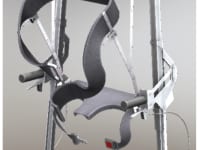Human-powered, ergonomic solution to problems associated with crutches. Among these are stress and injury to hands, wrists, armpits and upper body. Also, high energy expenditure, heightened risk of slipping or falling, difficulty in bending down and a need for constant vigilance.
This invention addresses these issues by:
1) Reducing or eliminating stress on hands, wrists, arms, armpits, shoulders and upper body.
2) Reducing energy expenditure.
3) Increasing stability.
4) Providing a seated resting option that is instantly available.
5) Providing balance and weight support for user while bending or squatting.
Prior attempts to develop a suspension crutch have mostly consisted of a swing seat or safety harness suspended from the axillary support area of conventional crutches. While offering some benefit, a new set of problems is introduced. The user’s weight on the suspension straps produces an uncomfortable lateral pressure against the torso. The harness also pulls on the crutches In sometimes undesirable directions, increasing the possibility of the crutches escaping from the stabilizing grip of the armpit, leading to a fall.
This invention is the first to solve these problems. The unique method of connecting the crutch elements keeps them rigidly aligned at a fixed distance apart and coordinating their motion such that they must swing forward or backward in parallel, or sideways at an equal but opposite angle of abduction/subduction.
This system, in conjunction with the multiple rigid suspension links and the torso and waist belts, and the wide, contoured seat, keeps the user comfortably and securely in proper alignment with the crutch elements without imposing pressure on the armpits. The crutch cross-linking system further introduces a stabilizing effect, making it almost impossible to fall sideways, or in a twisting motion. Thus the demands placed on the user’s vigilance and balance are reduced to preventing a forwards or backwards fall. These demands are further reduced if the additional set of legs are in use.
Navigational flexibility across uneven terrain or on stairs is enhanced with the optional mechanism of leveraged, real-time individual crutch-length adjustment.
A latching mechanism and extra pivot point in the harness suspension straps permits the user to selectively bend down (e.g. to reach something on the ground), unrestricted by the usual upper constraint, while maintaining full weight support on the seat.
The adaptive seat and harness system provides weight support in both the standing and swing-through phases of walking, as well as when the user wishes to stand still, or rest in a seated position.
In addition to the stated advantages for crutch-users, it should be noted that upwards of one-half of all wheelchair users retain some walking ability. This suggests a large subgroup that could return to a standing and/or walking posture, with all the physical and mental health benefits and improved quality of life that would follow.
The Swingrider could be a game-changer in developing countries that lack elevators, pavement and other disabled-friendly accommodations. Flexible design, low-tech or off-the-shelf components allow manufacture or servicing in rural, low-tech factories and workshops.
Video
Like this entry?
-
About the Entrant
- Name:John Threlfall
- Type of entry:individual
- Patent status:patented








